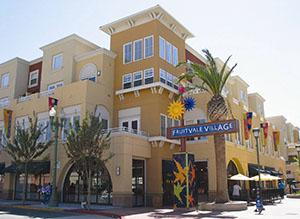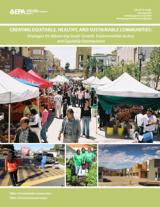Equitable Development and Environmental Justice
Overview
Equitable development is an approach for meeting the needs of underserved communities through policies and programs that reduce disparities while fostering places that are healthy and vibrant. It is increasingly considered an effective placed-based action for creating strong and livable communities.
Today, there are clear initiatives, tangible examples, and award-winning projects that demonstrate the approach as a means for rebuilding America's communities. The outcomes of equitable development are the result of clearly set expectations, collaborative problem solving, and persistent leadership.
It is a fair question to ask "how does equitable development differ from other place-based approaches?"
Equitable development is driven by priorities and values as well as clear expectations that the outcomes from development need to be responsive to underserved populations and vulnerable groups, in addition to using innovative design strategies and sustainable policies. Acknowledging and understanding both is necessary for sustaining environmental justice.
Lower-income citizens and people or color are successfully guiding the changes that occur within their communities rather than reacting to them. This unique narrative is often missing from prevailing planning, design, and place-based discussions. EPA sees value in elevating this narrative because it draws attention to solutions from environmental justice actions.
Environmental Justice as a Planning Issue
As a public policy issue, environmental justice is often framed and presented in the context of the law, public health, waste management, and public involvement. However, other factors contributing to the hardships experienced by communities with environmental justice concerns include failures in planning or enforcing proper zoning, or the incompatibility of land uses.
This relationship was understood by delegates who attended the First National People of Color Environmental Leadership Summit in 1991. An outcome of the Summit was the adoption of seventeen Principles of Environmental Justice. Exit Approximately one-third of these principles are relevant to planning, urban policy, and management of the built environment. The prevalence of this theme within the Principles of Environmental Justice suggests:
- Environmental justice strives to address environmental challenges in an upstream manner by being proactive;
- Environmental justice has a long history of targeting untenable practices in housing, land use, transportation, industrial siting, health care, and sanitation; and
- Environmental justice is a cross-cutting issue as evidenced by the fact that the disparate impacts of redlining, infrastructure decline, deteriorating housing, lead poisoning, industrial pollution, concentrated poverty and unemployment are related problems.
Problems that are interrelated require comprehensive solutions, and the solutions need to be accessible for persons who experience the disproportionate burden.
The concept of environmental justice is not foreign to planners. Until recently, the challenge has been:
- Framing how to implement it during the planning process.
- Visualizing the product from that process.
- Correcting the misperception that addressing environmental justice may slow down the planning process.
However, thanks to the tireless efforts of researchers and advocates, the creative thinking of planners and architects, and the compelling results of determined community builders, these barriers are coming down. Communities are finding ways to better align environmental justice and planning as complementary quality of life goals.
One method of alignment is through equitable development. Equitable development is simply a place-based approach for encouraging environmental justice. In the context of environmental justice and planning, equitable development improves public involvement; supports collaborative problem solving; and makes a visible difference in communities that are underserved, under-resourced, and overburdened.
Gentrification
Gentrification commonly refers to 'the process of neighborhood change that occurs as places of lower real estate value are transformed into places of higher real estate value.' In recent years, gentrification has become an increasingly common occurrence because of the growing popularity of urban centers and existing communities. Gentrification is a nuanced process whose outcomes may be viewed as:
- positive based on improvements to physical and economic infrastructure;
- negative when cultural assets and cherished institutions are compromised; or
- both positive and negative when important services (retail, housing, transportation, and the like) are provided, but are unaffordable by long-standing residents.
Some scholars argue gentrification is good because it contributes to job growth, a larger tax base, higher property values, and opportunities to expand services or offer new ones. On the other hand, failing to acknowledge the differential health burdens experienced by low and moderate income populations when communities transition, is not socially responsible nor sustainable.
In the context of environmental justice, national leaders offered an insightful and cogent position on the subject when the National Environmental Justice Advisory Council (NEJAC) issued the report Environmental Justice, Urban Revitalization, and Brownfields: The Search for Authentic Signs of Hope in December 1996. This scholarship is important because environmental justice proponents were sensitive to the fact that reinvestment activities had the potential to either alleviate vulnerabilities or amplify vulnerabilities that were experienced by persons living in communities that are underserved and over-burdened. Also, the report is a reminder of the necessity to properly analyze the environmental effects, including human health, economic and social effects, of Federal actions as required by the National Environmental Policy Act of 1969.
Gentrification is an environmental issue, and the principle of fairness suggests the burden of policies that are necessary for society – like protecting the environment – should not be borne by a small minority who happen to be victimized by their side effects. Concerns about gentrification should not be interpreted as unwillingness to embrace change or new development. Public push back often reflects frustration with past failures of the public involvement process, concern that cherished institutions may be lost, or fear of involuntary displacement.
The progressive path forward on gentrification requires expansive concepts for encouraging sustainable communities, like equitable development, not restrictive approaches. City officials, developers, policy makers, advocates, business owners and residents should expand their knowledge base, devise strategies, and form alliances that are deliberate in actively managing gentrification as well as the differential burdens that may beset populations and institutions that are less resilient to shifts in the market.
Equitable Development Workshop
The Equitable Development Workshop has been a feature of the New Partners for Smart Growth Conference since 2010. Through the workshop, EPA's Office of Environmental Justice and the Office of Sustainable Communities partner to deliver an interesting and informative program. 'Environmental justice' and 'smart growth' are connected issues. Both share the position that the environment is defined as "where we live, where we work, and where we play.' Each year, the workshop objective is to bring an increasing number of people from environmental justice and smart growth communities together to learn from one another.
Can't make it to the workshop? Follow along on Twitter Exit.
Equitable Development in Practice
ReGenesis Project - Spartanburg, SC
The ReGenesis Project easily reveals the connections between land use, environmental justice, and sustainability. In the late 1990s, Harold Mitchell, Jr. linked health concerns in the Arkwright and Forest Park neighborhoods within Spartanburg to the pollution in both communities. He formed an organization called ReGenesis to represent neighborhood interests in cleaning up contaminated and abandoned property as well as revitalizing the surrounding community. This project is a model for collaborative problem solving that shows how citizens can achieve extraordinary outcomes such as cleaning up two Superfund sites; managing vacant properties and brownfields; and conducting community design charettes. Since inception, ReGenesis has leveraged a $20K EPA grant into $270 million dollars in community reinvestment for a 500 acre site. Residents in Arkwright and Forest Park are demonstrating how past environmental injustices, caused by limited zoning restrictions and land use controls, can be corrected through community planning strategies.
Fruitvale Transit Village - Oakland, CA

The Fruitvale Transit Village reveals the key to creating truly sustainable communities is to be pliable. In 1990, the Bay Area Rapid Transit Authority (BART) had the option of advancing a construction proposal which lacked community support or working with residents of the Fruitvale District to devise a plan for the area. The Fruitvale community, with the support of the Unity Council, rejected BART’s proposal for a multi-level parking garage as being poorly conceived and designed. Residents in the community didn’t have objections to new construction. Instead, they wanted BART to plan with them rather than for them. Eventually, the transit authority decided it would be better to invest in public involvement and frame a vision that would be informed by the local knowledge of residents who would be impacted by the project. The outcome is a transit-oriented development that helps to connect the community rather than act as a buffer between neighborhood assets. Fruitvale Transit Village is a clear reminder that penetrating new audiences and leveraging untapped talent will be critical to the success of place-based initiatives.
Westside Specific Plan - National City, CA
The Westside Specific Plan is the outcome of collaboration among community, environmental and local government interests to create a successful neighborhood planning process. In December 2013, National City, California, raised the bar for neighborhood planning by completing the cleanup of a site to make way for 201 affordable housing units that will meet several community requests: the need for affordable living, access to public transit and access to open green space. The plan builds on an amortization ordinance passed by National City in 2006, and the regulation helps to phase-out non-compatible land uses. Residents of National City and their partners, including the Environmental Health Coalition (EHC), worked tirelessly together for ten years to ensure city plans accurately reflected community needs. Also, EHC produced a video learning tool Exit to share key lessons of community planning and community member involvement more broadly. Today, partners are celebrating Westside National City for its commitment to healthy neighborhoods.
Other Resources
- Creating Equitable, Healthy, and Sustainable Communities: Strategies for Advancing Smart Growth, Environmental Justice, and Equitable Development (2013). Discusses land use and community design strategies that community-based organizations, local and regional decision-makers, developers, and other stakeholders can use to build healthy, sustainable, and inclusive neighborhoods.
- Unintended Impacts of Redevelopment and Revitalization Efforts in Five Environmental Justice Communities (2006). Contains recommendations on avoiding the displacement that can follow successful brownfields cleanup and redevelopment.
- Breakthrough Communities: Celebrating the Victories of Environmental Justice and Planning Exit (2015). Celebration of the individuals involved in environmental justice work across the country and how their transformative actions are helping over-burdened and under-resourced communities become more healthy, viable and sustainable.
- Environmental Justice: A New Model for Planning in Underserved Communities Exit (2014). The webinar explores how environmental justice is a forward-thinking, sustainable approach, and experts share why a discussion about environmental justice is important given the renewed focus on social equity and planning among professionals.
- Nature Brought us Together Exit (2012). Bayview Citizens for Social Justice was the recipient of an EPA Environmental Justice Small Grant in 1997. The video summarizes how the residents of Bayview developed a plan to chart a course forward, for both the people and the landscape.
- Addressing Environmental Justice in Brownfield Communities (2009). Brochure discussing the work of EPA’s Brownfields Program to promote environmental justice.
- Addressing Community Concern: How Environmental Justice Relates to Land Use Planning and Zoning (2003). EPA sponsored a study that focused on how local government decisions on land use planning and zoning have—or have not—been used to address environmental justice issues in five selected communities where concerns about inequities have been raised.

